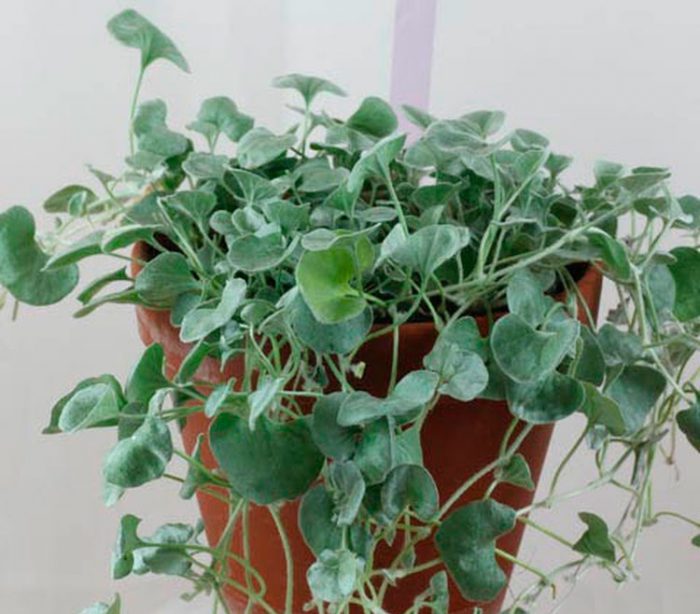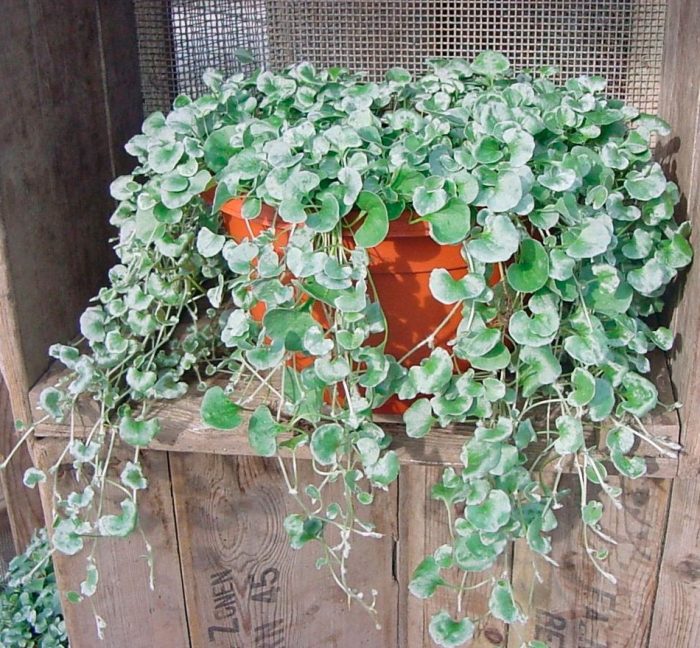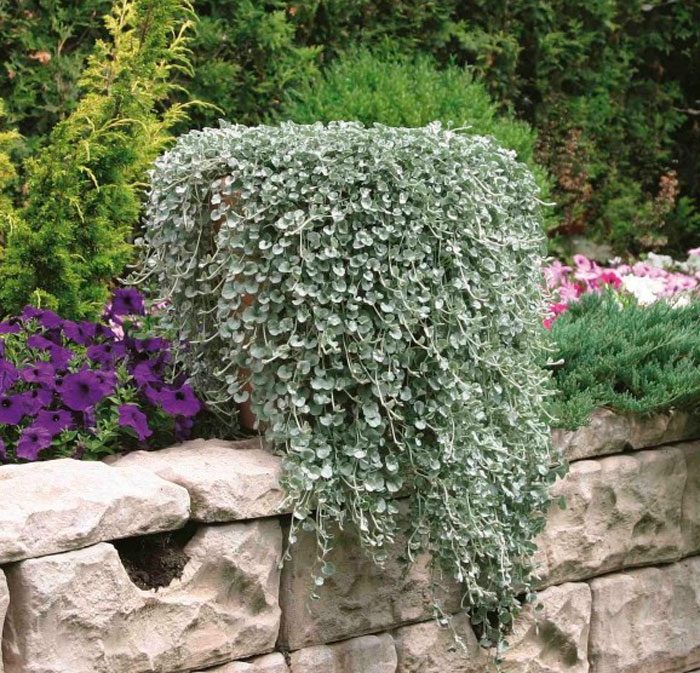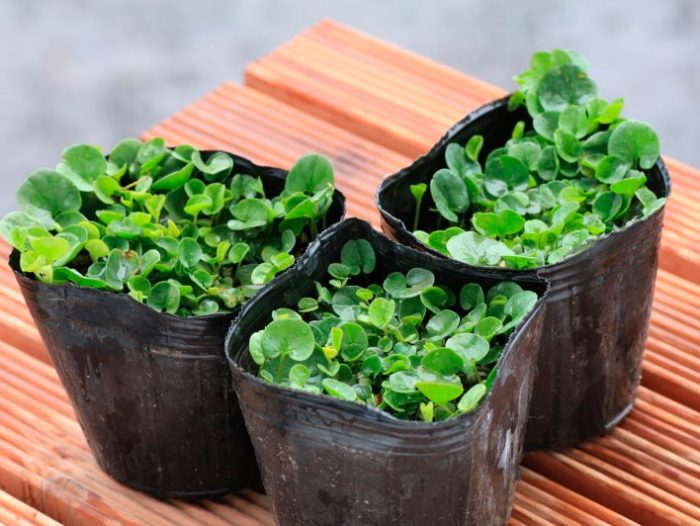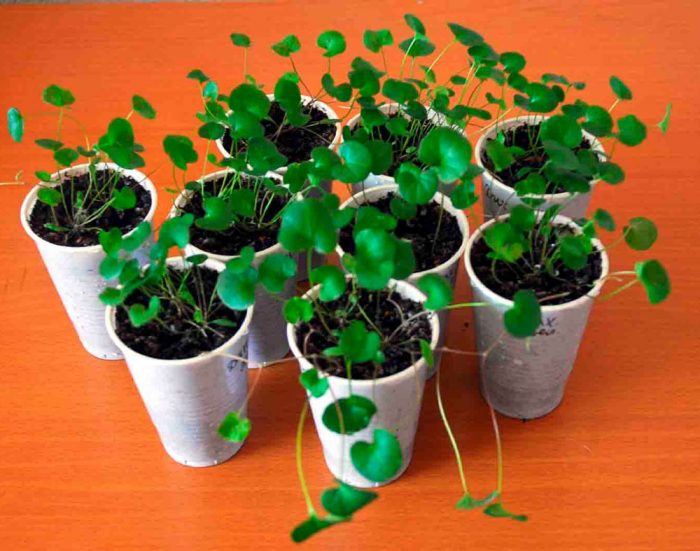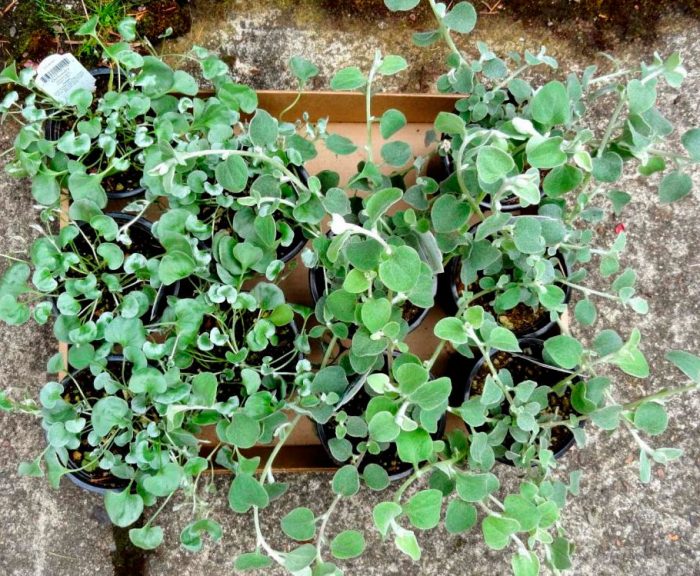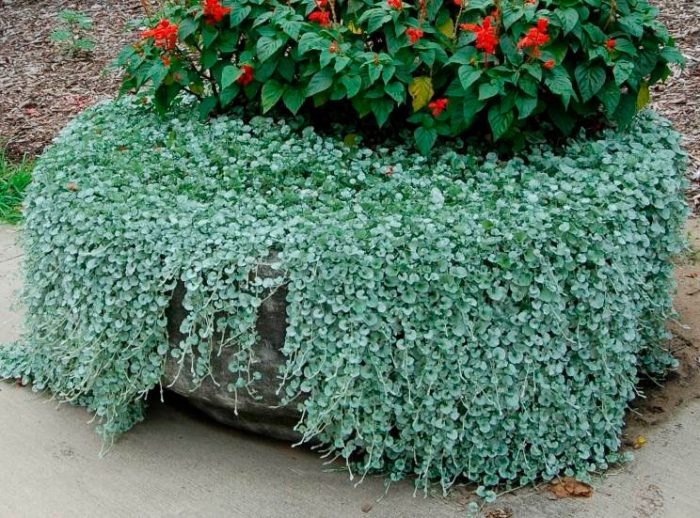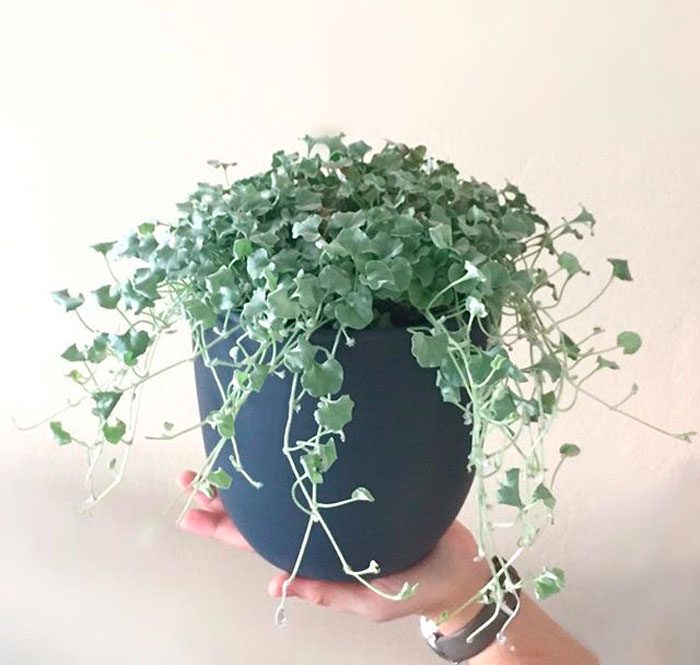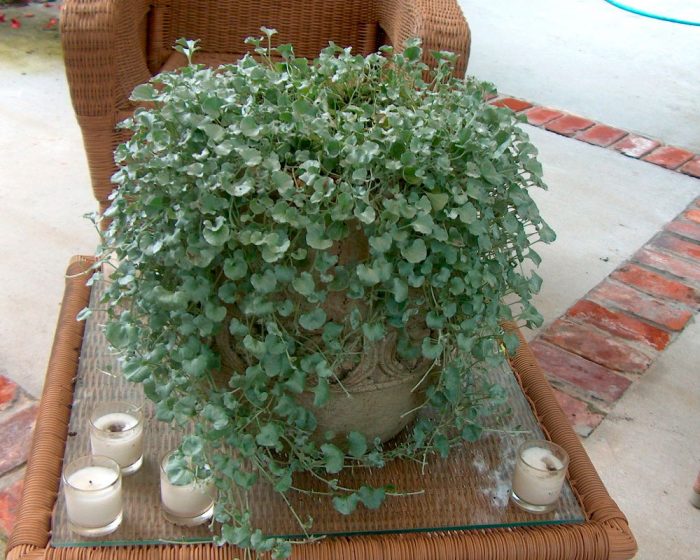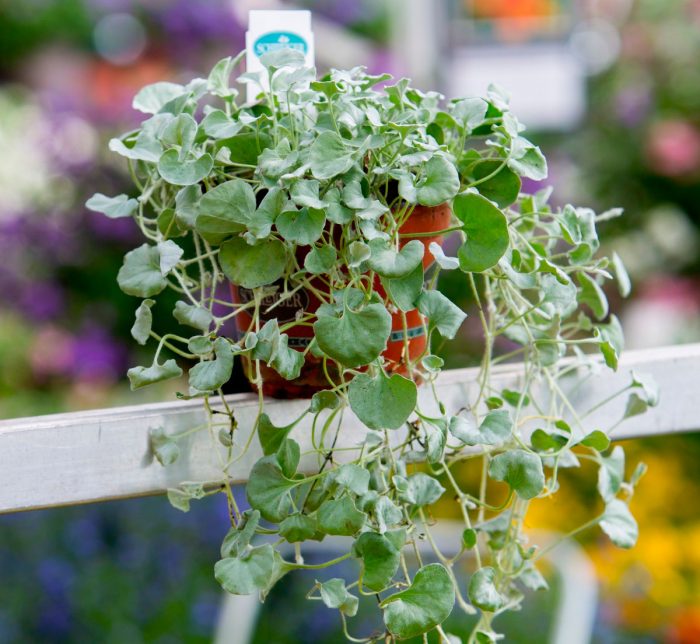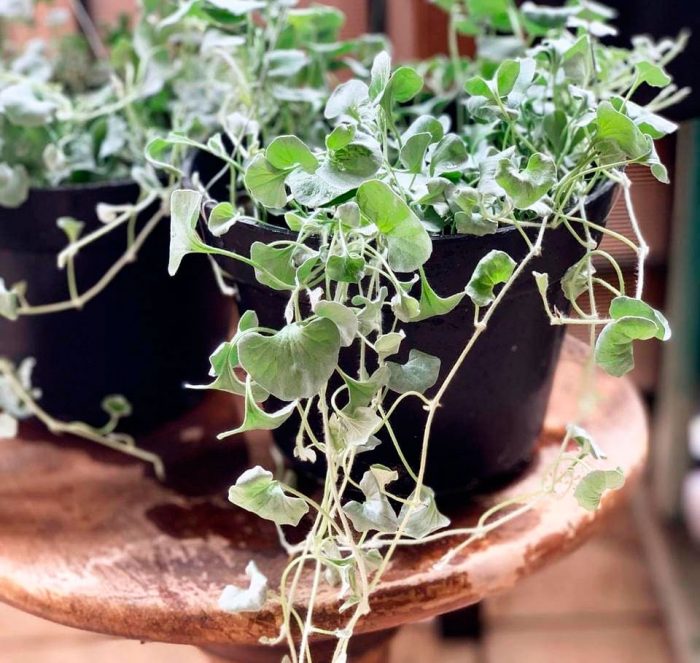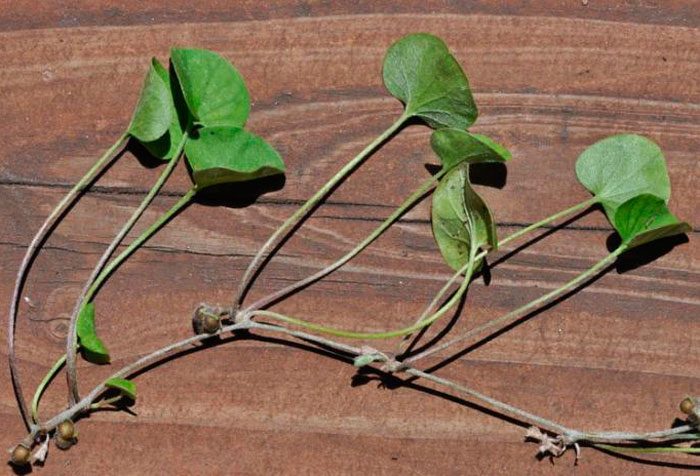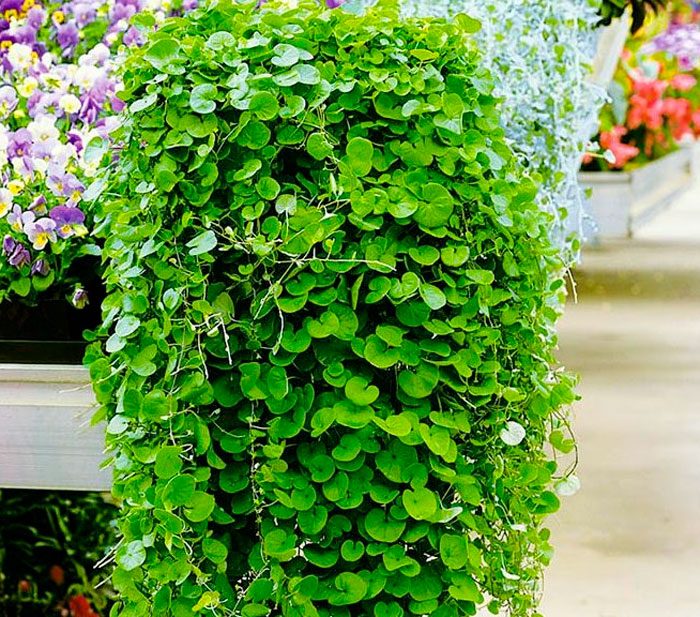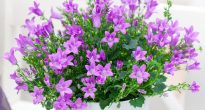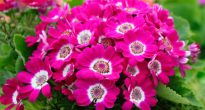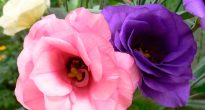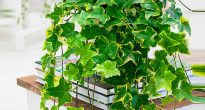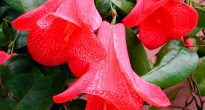The evergreen herbaceous perennial plant, Dichondra, is part of the Bindweed family. Plants such as kalistegia, morning glory and bindweed are considered related to dichondra. The name of this plant is derived from 2 Greek words that translate as "two grains", which is associated with the appearance of the dichondra fruit, which looks like a two-chamber capsule.
This genus has 10 species, in natural conditions they can be found in the humid regions of the subtropics and tropics of New Zealand, America, Australia and East Asia. Florists began to cultivate this flower quite recently, but at the same time designers have learned to make wonderful compositions with its help. That is why in 2004 at an exhibition held in Moscow, dichondra received a silver medal.
Content
Brief description of cultivation
- Bloom... Dichondra is cultivated as an ornamental leafy plant.
- Landing... Seeds for seedlings are sown in January or February, and young plants are planted in open soil from the last days of May to the second half of June.
- Illumination... Grows well in a sunny area, under diffused light, in a shaded area and in the shade. Varieties with silvery foliage are more light-requiring.
- Priming... Perfect for growing a well-drained loam culture with a pH of 6.6–8.0.
- Watering... Moisten the soil moderately, but systematically, and do it in the evening to avoid the appearance of burns on the leaf plates.
- Air humidity... During hot dry seasons, it is recommended to moisturize the foliage in the evening.
- Fertilizer... During the growing season, feeding is carried out every 15 days, for this, a complex mineral fertilizer with an increased content of potassium and nitrogen is used.
- Trimming and pinching... To make the plant more lush, at the stage of formation of the fourth pair of leaf plates, its stems are pinched. Also, regularly every 7 days, the stems are trimmed as they grow.
- Reproduction... Seeds, layering and cuttings.
- Pests... Whiteflies, fleas, nematodes and aphids.
- Diseases... Possesses high disease resistance.
Features of ampelous dichondra
Dichondra is a creeping evergreen plant that forms a dense carpet on the surface of the earth. The plant has a superficial root system. The stems reach no more than 15 centimeters in height, but their length varies from 100 to 150 centimeters. Branched creeping shoots are able to quickly root due to the surface roots that form in the internodes. Flowering is observed in May – August, during this period the plant opens flowers that do not have a high decorative value, they reach from 0.2 to 0.3 cm in diameter and are painted in lilac, pale green and light yellow. Pollination of flowers is due to small insects. The shoots are decorated with lush foliage, its shape is round (similar to a coin), and in diameter it can reach 5–25 mm.
Ampel dichondra is very popular with gardeners. In regions with mild and warm winters, it is cultivated as a perennial, and where it is very cold in winter, it is grown as an annual. In the warm season, a room dichondra is taken out onto the terrace or balcony, and brought into the house for the winter.
Growing dichondra from seeds
Sowing
If dichondra is grown in the garden as an annual, then it can be propagated by seeds, cuttings (rooting is carried out in the summer) and layering. If this plant is not yet on your site, then the generative (seed) method is used for primary cultivation, while you can grow a flower through seedlings, or you can sow seeds directly into open ground.
Sowing seeds for seedlings is carried out in the middle of the winter period, or rather, in January or February. Before starting sowing, the seed is immersed in water overnight, to which a growth stimulating agent is added. The container is filled with a pre-disinfected peat soil substrate intended for growing seedlings, which is spilled with sodium humate. The seeds are buried in the soil mixture by no more than 0.8 cm. It is recommended to sow seeds in small pots, with 2 or 3 seeds in each of them. Cover the top of the container with glass (film), and do not forget to leave a small hole for ventilation. Crops are transferred to a warm (22 to 24 degrees) place with bright diffused light.
Growing seedlings
If done correctly, then the first seedlings may appear only 7 days after sowing. The emerging seedlings are characterized by extremely slow growth, therefore, the shelter from the container is removed only after they become stronger.
Do not forget to systematically water the young plants, and also gently loosen the surface of the soil mixture. Remember that if the plants do not have enough light, then they can stretch out a lot. Systematically, a small amount of a growth stimulating agent should be added to the water intended for irrigation. The picking of seedlings is carried out during the development of 3 or 4 of a real leaf plate. In the event that you will grow the plant as an ampelous plant, then you need to transplant it immediately into a hanging basket or pots. But if you need seedlings for planting in open ground, in this case, the pick is carried out in larger pots. Before planting seedlings in the garden, it must be hardened.
Planting dichondra in open ground
What time to plant
In regions with warm and mild climates, dichondra is used to create an alternative lawn. This is possible due to the fact that it is resistant to frost, and also to trampling. Ampel dichondra is transplanted into the garden only after 1.5–2 months have passed after the seedlings appear. In the northern regions, dichondra seedlings are planted around the first half of June, and in the southern regions, in May. This flower grows well both in sunny areas and in shade.But it should be borne in mind that the variety with silvery foliage is more light-requiring. Dichondra does not have any special requirements for the composition of the soil, however, it grows best on well-drained loamy soil with a pH of 6.6–8.0.
Landing rules
If you intend to grow dichondra as a ground cover plant, then you need to remember that it is extremely slow in growth. That is why during planting in the ground between the bushes, you need to maintain a distance of 10 to 15 centimeters. The depth of the planting holes should be such that the root system of the plant, taken together with a lump of earth, is placed in them. Gently transfer the seedlings into the holes and fill them with soil, tamp the surface and water abundantly.
Dichondra care in the garden
Watering
If you take care of the dichondra correctly, then when grown in the garden it will retain its high decorative effect for 5-7 years. Although this crop is drought-resistant, watering should be systematic. However, it is impossible to allow stagnation of liquid in the soil. In order to prevent burns on the surface of the leaf plates, it is recommended to water such a flower in the evening. On hot days, try to moisturize the bushes in the evening, as dichondra reacts positively to this procedure.
Top dressing
In order for the dichondra to be as effective as possible, systematically feed it every 15 days throughout the growing season. To do this, use a mineral complex fertilizer with an increased content of nitrogen and potassium.
Pruning
When the eighth leaf plate forms at the bush, it is recommended to pinch it. Then, as the shoots grow and branch out, prune. As a rule, during the summer period, on average, one haircut is carried out every 15 days.
It is necessary to pull out the weeds carefully, because the root system of the dichondra is superficial and located at a shallow depth, so it can be very easily injured.


Watch this video on YouTube
Dichondra care at home
It is not difficult to grow dichondra at home, but you need to remember about its features. They take care of it in almost the same way as for other ampelous ornamental deciduous plants, for example, creeping ficus, asparagus, zebrin, chlorophytum, rooting ficus or saxifrage.
Illumination
The amount of light that a plant needs depends on the color of its foliage, for example, varieties with silvery leaves need a lot of light, and green-leaved varieties can grow in a sunny or shaded place, or even in the shade.
Temperature regime
Throughout the year, in the room where the flower is located, the temperature should be between 18 and 25 degrees. However, if in winter he is in a room that is not heated, make sure that it is not colder than 10 degrees, otherwise the dichondra may die. If the room is hot all the time, then this has an extremely negative effect on the growth and development of the bush.
Air humidity
This flower is able to grow normally at low air humidity. However, if it is moisturized every day, then the green mass will increase up to 25 percent. If you spray dichondra regularly in the morning and evening, then the green mass will grow 2 times faster. If the flower is warm in winter (above 18 degrees), then special attention should be paid to moisturizing the foliage.
Watering
Water the flower abundantly, but make sure that no liquid stagnation is observed in the soil mixture. In this regard, a good drainage layer must be made at the bottom of the pot. In the event that you cannot water the flower for a long time, then it is able to live for some time even with the complete drying out of the earthy coma. As soon as the bush is watered, it will recover very quickly.
Fertilizer
Dichondra should be fed in the period from April to September 1 time in 15 days. To do this, use fertilizer for decorative deciduous indoor plants, for example, Ideal. And in order to accelerate the growth of deciduous mass, the flower can still be fed with Agricola once every 7 days. With a cool winter, you do not need to feed the plant.
Pruning
In order for the bush to be dense, it will need regular pruning and pinching. When preparing the dichondra for winter, it must be cut off. In order for it to be more lush, carry out a systematic pinching of the ends of the stems, and after they are very elongated, they are cut off. In culture, shoots in length can reach about 200 cm, and if the climate is warm, then up to 600 cm.
Landscape designers often use dichondra to create an imitation of a "running stream" on the garden plot; it looks very unusual and beautiful. After the cascading shoots reach the surface of the soil, they quickly take root, and the ampelous plant becomes a ground cover. Decide for yourself whether to shorten the stems regularly or they will grow freely, but if you do not pinch the ends of the shoots, then the bush will not be so lush and effective.
Appropriate place
This flower grows and develops well both at home and in the open field. The surface roots forming in the internodes of the shoots allow the lashes to root very quickly, due to which the bush forms a solid carpet of silver or green color, which does not lose its color even in winter.
A flower grown as an ampelous plant has shoots streaming down in a green or silvery waterfall. A basket or pots with a flower can be hung both in the living room and on the veranda, loggia, terrace or balconies.
Diseases and pests
Dichondra has a very high resistance to all pests and diseases. The fact is that it is essentially a weed, and if you take proper care of it, then there will be no problems with it. But nematodes, which are microscopic worms that develop in conditions of high humidity, can still harm the plant. Due to nematodes, the plant has mutations that cause its death. In this case, nematodes can settle both on those dichondra that grow in the open field, and on those grown in indoor conditions. It is very difficult to get rid of nematodes; therefore, it is recommended to destroy the infected bush, as well as the land in which it grows.
Much less often, aphids, whiteflies or fleas settle on the plant. In order to get rid of these insects, acaricidal preparations are used, in addition, it is recommended to adhere to preventive measures:
- the surface of the soil around the bushes should not be covered with mulch, and pull out weeds exclusively with your hands;
- if the bushes have become a dense carpet, then it is necessary to reduce the frequency of watering;
- make sure that there is not too much nitrogen in the soil.
Reproduction methods
How to grow dichondra from seeds is described in great detail above. This plant can also be propagated by rooted cuttings and cuttings. Vegetative propagation methods are easier and more efficient than seed propagation. When the lashes are pinched or cut off, there are many stem apical sections that can be used as cuttings. They take root very quickly. In winter, rooted cuttings are recommended to be grown indoors, and with the onset of spring they are transplanted to a permanent place.
Dichondra propagation by layering is much easier. The fact is that the stems, in contact with the surface of the earth, root themselves. Separate the resulting cut when you need it and plant it in a new place.
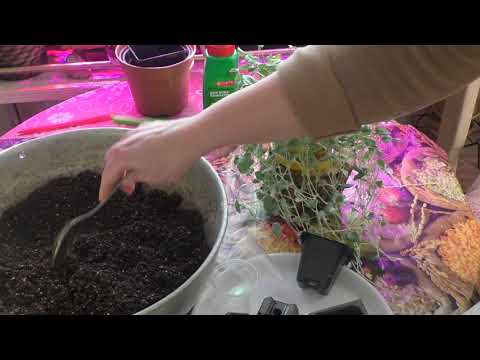

Watch this video on YouTube
Wintering of perennial dichondra
In regions where winters are warm and mild, perennial dichondra can hibernate outdoors.To do this, the bush is covered with a layer of soil, and covered with a film on top, which is covered with flying leaves. In regions with frosty winters, the bush is transferred to a greenhouse with subtropical and tropical cultures, it can also be placed on a glazed balcony, covered veranda or loggia. Dichondra should be located in a well-lit room, where the air temperature should be from 11 to 15 degrees. During this period, the flower is not fed, but it is rarely watered and with a small amount of water.
A plant grown in an open field must be dug up in the fall and transferred to the basement together with a lump of earth, where it will stay in suspended animation until spring. In early spring, cut the stems with root suckers from the mother liquor, while the remaining root system is transplanted into the garden.
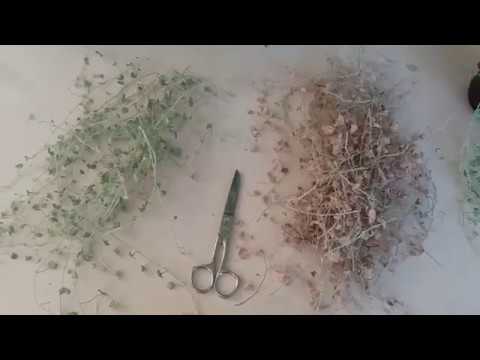

Watch this video on YouTube
Main types and varieties
In natural conditions, you can meet at least 10 types of dichondra. However, only 1 species is grown in culture - Dichondra repens, or Dichondra argentea, which is a herbaceous evergreen plant (a detailed description of the species is given above).
This species has a couple of varieties, namely, silver dichondra and green dichondra, which are very popular in culture:
Emerald Falls
The shoots are decorated with green leafy plates of a round shape. A bush growing in a sunny place has a smaller foliage than that of a dichondra that is in a shaded area.
Silver Falls
The foliage of this variety is silvery. This plant has longer whips than those of Emerald Falls, but they are less lush.


Watch this video on YouTube

